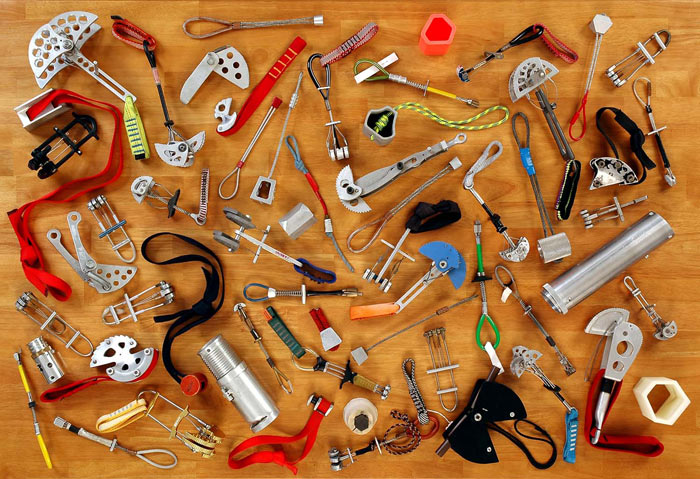For true connoisseurs of rock climbing and mountaineering, here are some fascinating facts from the history of mountaineering equipment.
Drilled Nuts
After twenty years of research, the author is truly pleased to finally be able to add such an amazing collection of drilled nuts, from the smallest to the huge, to the exhibition at The Nuts Museum. We have had several of these examples (some of which were processed by Harry Smith himself), but none of them had the original cord. John Cheesmond also contributed to the museum’s collection by donating several large drilled nuts to complement those already strung on a rope.
In the mid-1960s, John Cheesmond spent two years working at an outdoor recreation centre in Derbyshire, where Joe Brown also worked. So he remembers how one of the instructors (unfortunately, John forgot his name) drilled out ordinary nuts, which he and Joe strung on nylon straps and cords.

This “three-strand rope” was widely used by British climbers in the fifties up to the sixties. And to distinguish the rope with nuts from others, it was “at home” painted red. The thinner cord was called “sling”, and the thicker one – “three-quarter weight”, although it weighed twice as much. “Three-quarter” (approximately 850 kg breaking strength, as claimed by the manufacturers) was often used as a 90-meter half-rope by those who dared to take on more difficult routes or were inclined to “artificial ascent” with the help of pitons, slings, wooden wedges, etc. A rope of this weight was not very pleasant to use on long rappels, especially with its thin braid!
In late 1963, members of Bruce Bedford’s caving club, the Chelsea Speleological Society, were busy preparing for an expedition to the Triglav Cave in the Julian Alps. The participants were aiming for a descent of up to 300 meters, so they prepared a sufficient number of ladders made of a special magnesium alloy. What they ended up with was a lot of steel cable, crimping tips, and a rented Talurit press.
Up until this point, the climbing industry had been using nut holders made from regular nuts on nylon cord. Bedford and company had an idea: use steel cable instead of rope, which also allowed them to use smaller nuts. So they made some crimped steel nut holders for their own use. This was in 1963.
At the end of the “treasure hunt,” Bruce Bedford gave one of these original metal nut holders to fellow club member George Fletcher, who generously donated it to our museum. This specimen was made in the second half of 1963 or the very beginning of 1964 by Pete Thompson, another member of the caving club.

The first official metal bookmarks were made by Charles Curtis in 1961-62 and were called Little Mesters (dialect version of English Little Masters). These may have been the very first chocks to be crimped using the Talurit ferrule and press system…
Trevor Peck’s Crackers were made from round ribbed steel or duralumin, cut to the required length. The earliest products, in which the ends of the cable were bitten and soldered with silver into a copper sleeve, were certainly in use in 1962. But it was not until 1967 that cable began to be crimped using the Talurit ferrule and press system. Unfortunately, we have no exact data on the beginning of the use of this technology by Troll and Clogwyn Climbing Gear, as they were founded in 1964 and 1966 respectively. Therefore, the original metal Bruce Bedford caches from the Chelsea Speleological Society can be consideredthe first examples of their kind.
Porter Nuts: Many climbers have experimented with double and opposition nut designs for years. One of the first to improve on the system was Charlie Porter. In the early 1970s, Porter owned a machine shop in Briceburg, just downriver from Yosemite Valley. There he invented his own aluminum stoppers: he doubled the heads in opposite directions, crimped the ends of the cable, and added adjustable sliding wedges. Porter sold these handy nut designs privately to many climbers, so some of them still exist. They were also available in limited quantities in stores.
Porter Gear #4, 5, and 6: The father of these large and extremely rare caches was also the legendary climber Charlie Porter. The Nuts Museum has recently been replenished with a full set.
|
|

Monkey Paws Bookmarks (from English “monkey paws”): John Middendorf, the founder of the company “A5”, decided to part with a couple of Monkey Paws prototypes and donated them to our museum. The “paws” did not go into commercial production. John made about 30 prototypes and a batch of 10 finished versions.
The chock is a sliding mechanism made of three parts: a ball nut and two grooved wedges, which Middendorf invented in 1987. His concept was six months ahead of the production of Ball-Nut or as they are also called Lowe-Ball! Ball-Nut inventor Steve Byrne saw John’s design and assembled his own version from two parts, and then patented it.
The photo shows individual distorted elements of the chock – this is the result of its strength testing, which was carried out in an open space using a hydraulic puller. But the very fact that the cable broke, and the main parts of the chock did not pop out, proves the effectiveness of the design.
Chocks Crackers by mountaineer John Eubank are very rare. In Australia, they even became a cult. John made them in 1968; sizes – from “A” to “K” for cracks from 3/8 to 3.5 inches.

Unlike the English grooved Peck Crackers, these were cut and drilled from a hexagonal block. John Eubank is a legendary climber who also developed the Australian classification of route difficulty.
A new addition to the museum collection is the Acorn bookmark (from the English “acorn”) of the smallest size!
This “acorn” has been preserved in good condition in its entirety: both the long “three-strand rope” and the machine nut are present. In the early 1960s, British climbers wore their Acorns around their necks. This Acorn belonged to Hank Harrison of the Summit Club, with whom John Brailsford climbed the east face of the Petit Grepon in the early 1960s.

After nearly twenty years of searching and some pretty despondent moods, two of the three Forrest Mountaineering extractors have finally made it to the Nut Museum. But if it weren’t for Joseph Healy and his genuine interest and generosity, it’s unlikely they would have been found.
The Bam Nut Extractor is the “Roll Royce of extractors.” It was developed by Forrest Mountaineering in the mid-1970s as a multi-purpose clean climbing tool that could be used to insert and extract nuts and slings like a hammer or even as a chock itself. The aluminum head fits well in crevices from 1 ½ to 2 ¼ inches wide. It also has enough weight to set and test the chock. Heat-treated chrome-moly steel was used for the handle/hook, and the hex head was made of the same material with an admixture of aluminum. Both parts were tightly mounted; a steel Spirol spike served as a backup belay point.
In 1980, Forrest released a slightly modified version of the Bam Nut – the Crag Dagger, which was already without an aluminum head.
In the two photos above: Bam Nut and Crag Dagger extractors, Bam Nut head, fragment with the product brand, mythical Wire Nut Tool.

In 1993, Bill Forrest kindly agreed to lend his gear and send it to Corsica. It was not so easy for him to part with his treasures, since he was still actively climbing, and it was impossible to replace the gear. Among other things, there was a wire extractor. The author was able to take a good photo of this rare instrument, but the original itself, of course, had to be returned to its owner…
The author never saw this treasure again, but after viewing the author’s website, Bill Forrest generously agreed to send it again. Rumor has it that when the wire extractor returned to its native land and was reunited on the shelf with the entire Forrest family, they had a wild party. Dave Rearick created his own type of chock from Osage orange wood. Dave and George Hurley used them for the first ascent of the Twister route using only wooden chocks in 1973. Dave Rearick’s chocks, or Plugs as he called them, are safe and very effective: he tested them thoroughly. Dave gave Pat Ament a complete set, including the Clapper, an adjustable wooden chock for wide cracks. The author is still trying to get Pat to give him details of its construction and good photos, as he wants to make an exact replica of this truly interesting invention for a museum.

The history of this set of six wooden bookmarksThe story of the wooden chocks is as follows: Dave Rearick gave them to Bob Ryan, who in turn gave these treasures to the author at the Chock Museum. “There’s also a funny story about them,” Bob says. “I was talking to Dave and he reminded me of the time I was leading and fell on the third pitch of the Werk Supp route. That was in May 1978. Well, the bookmark was stuck so tightly that I had to go back with a crowbar to get it out.”
And the latest news from the Bookmark Museum. After twenty years of searching, the author finally managed to add a very rare item to the collection – a bookmark by Charles-Moser Grupp!

From a historical point of view, this example is really interesting. A mention with an image can only be found in an old article by Henry Agresti, published in the French magazine La Montagne et Alpinisme in 1977. Grupps were classified by size from No. 1 to 4, of which No. 4 is the smallest size. These were the first French chocks, which were patented in 1973 (patent FR 2.229.432). The internal composite wedge is probably made of nylon (polyamide 6.6).
A notebook-made reality!
Sometimes a vague idea, born somewhere on the rocks (or sometimes in the bathroom…), can end up in a notebook. And if it is really lucky, it can come to the attention of some rock fan. I would like to think that the reader was interested in seeing the prototypes that entered the collection of the Bookmark Museum (in 2006), from the MOAC to the latest camming devices. By the way, some of them are still waiting for their turn in the notebook to reveal their ancient secrets, but a little later.
It took a lot of energy, patience and commitment to collect all these treasures. But the collection would not have been possible without the trust, faith and shared passion of many generous donors.

Looking at these sophisticated instruments, it seems that the time when we carried pebbles in their pockets, a long time ago. Although…
Author of the article: Stéphane Pennequin

E-Mail: [email protected]
Translation: ALP Project
This translation of the article is subject to the law on “Copyright”. Reproduction of material on other resources is prohibited!






